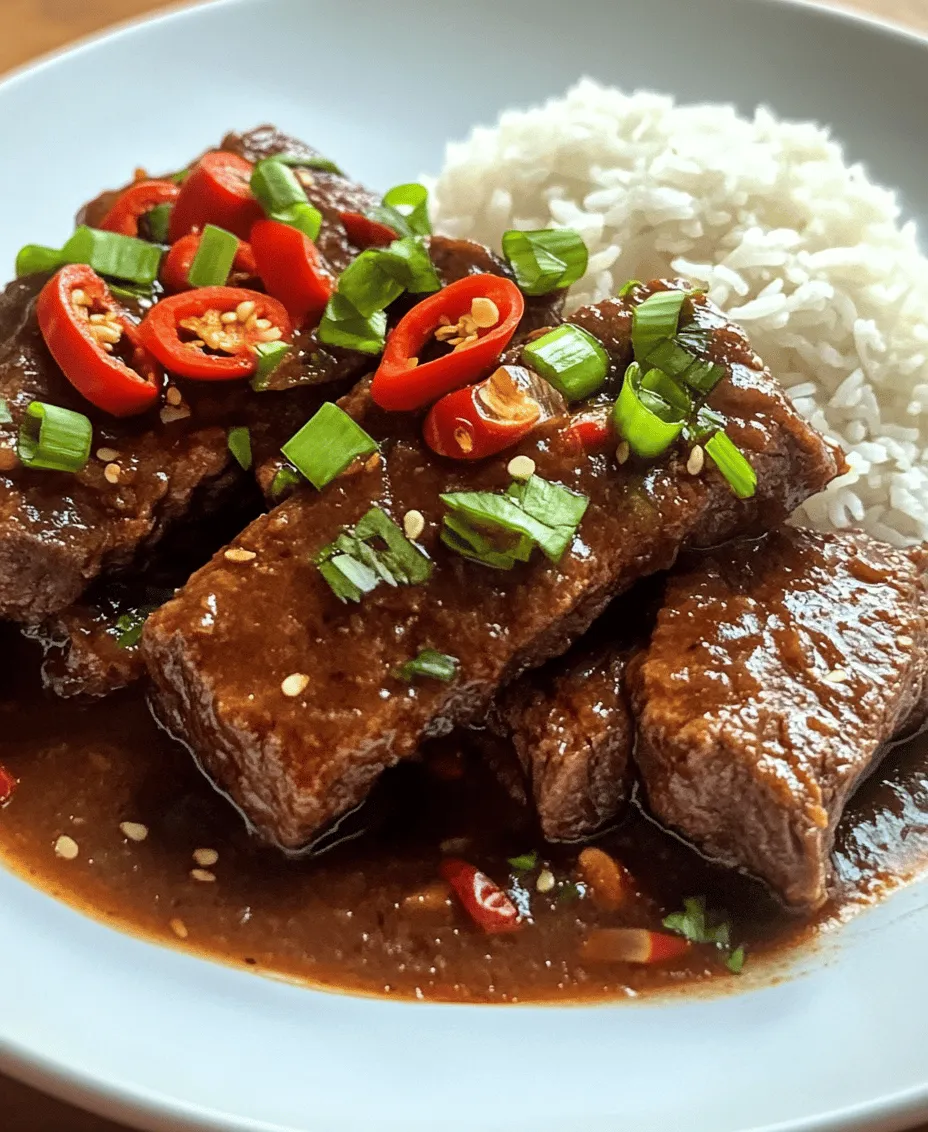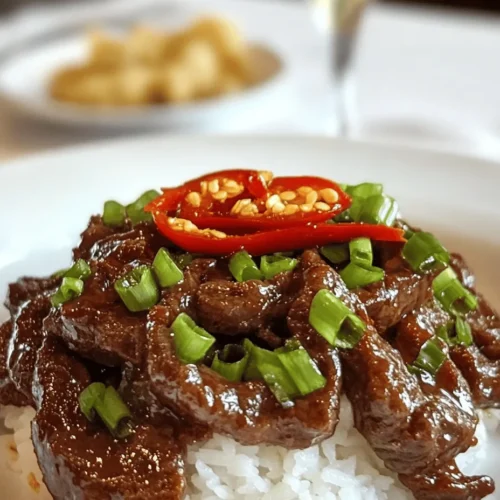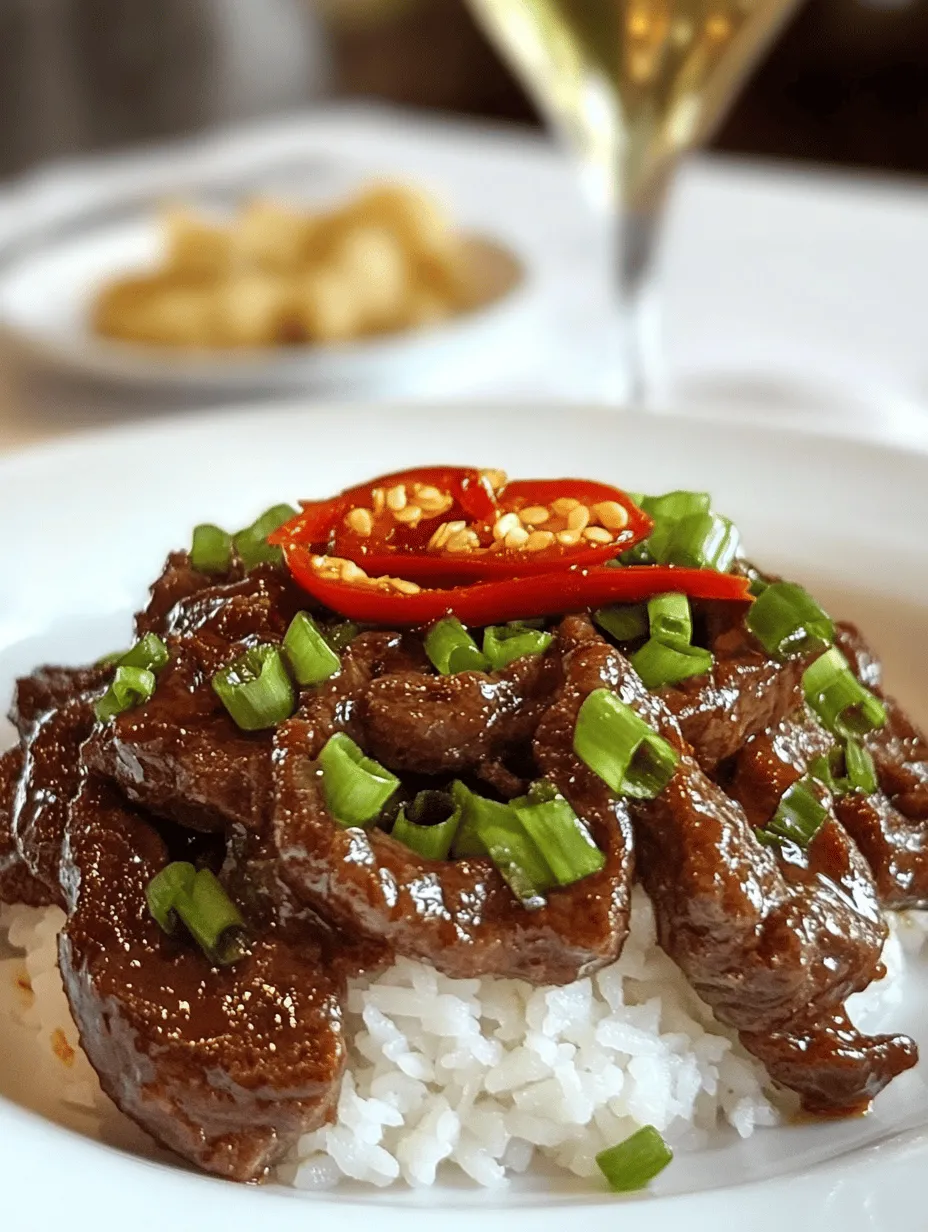Introduction
Crispy Chilli Beef is a beloved dish that has won hearts across the globe, especially within the realm of Asian cuisine. This dish brilliantly combines the rich flavors of tender beef with a medley of vibrant spices and sauces, resulting in a culinary experience that is both mouthwatering and satisfying. The crispy texture of the beef, paired with the delightful heat of chilli and the sweetness of sauces, creates a perfect balance that appeals to a wide range of palates.
Whether you are hosting a casual family dinner or planning an extravagant festive gathering, Crispy Chilli Beef is an excellent choice that can elevate your menu. Not only is it visually appealing, but it also delivers a burst of flavors that can impress your guests and leave them reaching for seconds. In this article, we will delve into the intricacies of preparing this delightful dish, from selecting the right ingredients to mastering the cooking techniques that will ensure your Crispy Chilli Beef is nothing short of perfection.
Understanding the Ingredients
To create a truly memorable Crispy Chilli Beef, it is essential to understand the key components that contribute to its unique flavor and texture. Each ingredient plays a vital role, and the quality of these ingredients can significantly impact the final dish.
Beef Selection
The foundation of any great beef dish begins with the meat itself. For Crispy Chilli Beef, selecting high-quality cuts such as flank steak or sirloin is crucial. Flank steak is particularly favored for its tenderness and flavor, making it an ideal choice for stir-frying. Sirloin, on the other hand, offers a slightly richer taste and can also yield excellent results. Regardless of your choice, ensuring that the beef is fresh and well-marbled will enhance the dish’s overall quality.
Coating Ingredients
Achieving that signature crispy texture is where the magic happens. In this recipe, the combination of cornstarch and all-purpose flour plays a pivotal role. Cornstarch is known for creating a light, crispy coating that adheres well to the beef, while all-purpose flour provides a slightly denser texture that helps form a protective barrier during frying. The balance between these two ingredients is essential; too much flour can lead to a heavy crust, while too little may result in a soggy exterior.
Flavor Profile
The flavor profile of Crispy Chilli Beef is a harmonious blend of spicy, sweet, and savory notes. Central to this profile are sweet chilli sauce and soy sauce. Sweet chilli sauce offers a delightful sweetness alongside a mild heat, enhancing the dish’s appeal without overwhelming the palate. Soy sauce, on the other hand, adds a savory umami depth that rounds out the flavors beautifully. Additional spices such as garlic, ginger, and fresh chilies are often incorporated to elevate the taste, providing aromatic qualities that make this dish truly irresistible.
Preparation Steps for a Perfect Crispy Chilli Beef
Now that we have a solid understanding of the ingredients, it’s time to dive into the preparation steps that will guide you in creating the perfect Crispy Chilli Beef. Follow these detailed instructions to ensure clarity and ease in your cooking process.
Step 1: Slice the Beef
Start by slicing your beef into thin strips, about 1/4 inch thick. This size is crucial as it allows for quick cooking, ensuring the outside becomes crispy while the inside remains tender. It is advisable to slice the beef against the grain, which will help in achieving a more tender bite. If you find it challenging to slice the beef, consider partially freezing it for about 30 minutes. This makes it easier to cut evenly.
Step 2: Prepare the Coating
In a large mixing bowl, combine 1 cup of cornstarch and 1/2 cup of all-purpose flour. Season the mixture with salt and pepper to taste. This seasoned coating will not only adhere to the beef but will also add an extra layer of flavor. Toss the beef strips in the coating mixture until they are fully covered, ensuring an even distribution.
Step 3: Heat the Oil
Choose a large, deep skillet or wok for frying. Add enough oil to cover the bottom of the pan and heat it over medium-high heat until it reaches a temperature of about 350°F (175°C). To test if the oil is ready, drop a small amount of the coating mixture into the oil; if it sizzles upon contact, the oil is hot enough for frying.
Step 4: Frying the Beef
To achieve optimal crispiness, it is essential to fry the beef in batches. Adding too many pieces at once can lower the oil temperature and lead to greasy, soggy meat. Carefully add a portion of the coated beef strips to the hot oil, ensuring they are not overcrowded. Fry them for about 2-3 minutes, or until they turn golden brown and crispy. Use a slotted spoon to remove the beef from the oil and transfer it to a plate lined with paper towels to drain excess oil.
Step 5: Make the Sauce
While the beef is frying, you can prepare the sauce to coat your crispy beef later. In a separate bowl, combine 1/2 cup of sweet chilli sauce with 1/4 cup of soy sauce, along with minced garlic and ginger. Mix well to create a fragrant sauce that will perfectly complement the crispy beef. The combination of sweet and savory notes in this sauce will enhance the overall flavor profile of your dish, bringing everything together beautifully.
Frying Techniques for Optimal Crispiness
Achieving that coveted crispy texture requires attention to detail, particularly when it comes to frying techniques. Understanding the differences between shallow frying and deep frying can help you make an informed choice based on your kitchen setup and preferences.
Shallow Frying vs. Deep Frying
Shallow frying involves adding a smaller amount of oil, just enough to cover the bottom of the pan, while deep frying requires fully submerging the food in oil. Both methods can produce crispy results, but they differ in terms of cooking time and the amount of oil used. Shallow frying is often quicker and uses less oil, making it a more economical option. However, deep frying can provide an even crispier finish, as the food is surrounded by hot oil, allowing for a more consistent cooking temperature.
Oil Temperature and Testing
Maintaining the right oil temperature is crucial for achieving crispy results. If the oil is too hot, the outside of the beef may burn before the inside is cooked through. Conversely, if the oil is not hot enough, the beef will absorb excess oil, resulting in a greasy texture. As mentioned earlier, a good way to test the oil’s readiness is by dropping a small amount of the coating mixture into the pan. Additionally, using a thermometer can help you monitor the oil temperature accurately.
Draining Excess Oil
After frying, it is essential to drain any excess oil from the beef. Place the fried beef on a plate lined with paper towels to absorb the oil, ensuring that the final dish is not overly greasy. This step is vital, as it allows the natural flavors of the beef and the sauce to shine through without being overshadowed by the heaviness of excess oil.
Crafting the Sauce: Balancing Flavors
The sauce is the heart of Crispy Chilli Beef, and crafting it requires an understanding of how each ingredient contributes to the overall flavor profile.
Key Components of the Sauce
The primary ingredients for the sauce include sweet chilli sauce, soy sauce, minced garlic, and ginger. Each component plays a distinct role in creating a harmonious flavor balance. Sweet chilli sauce provides the necessary sweetness and mild heat, while soy sauce adds depth and umami richness. Garlic and ginger introduce aromatic qualities that elevate the dish’s complexity.
Flavor Contribution
As you prepare the sauce, consider the proportions of each ingredient. Adjusting the amount of sweet chilli sauce can enhance or reduce the sweetness, allowing you to tailor the dish to your taste preferences. Similarly, adding more soy sauce can deepen the savory notes, while a touch of extra ginger can provide a refreshing zing. Finding the right balance is key to making a sauce that complements the crispy beef without overpowering it.
In the following sections of this article, we will delve deeper into the finishing touches for your Crispy Chilli Beef, including tips on presentation and creative serving suggestions. This dish promises to be a crowd-pleaser that showcases the vibrant flavors of Asian cuisine, making it a must-try for any culinary enthusiast.

Options for Customizing the Sauce Based on Personal Taste Preferences
One of the most delightful aspects of preparing Crispy Chilli Beef is the versatility of the sauce. While the traditional recipe delivers a perfect balance of sweet, spicy, and savory, you can easily customize it according to your preferences. Here are some suggestions for tailoring the sauce to suit your taste:
1. Adjusting Sweetness: If you prefer a sweeter sauce, consider adding more sugar or a splash of honey. Conversely, if you like a less sweet flavor profile, reduce the amount of sugar and enhance the savory notes with soy sauce or oyster sauce.
2. Modulating Heat: The heat level of the sauce can also be fine-tuned. For those who enjoy a milder spice, reduce the amount of dried red chilies or use a less potent pepper. For an extra kick, add fresh sliced jalapeños or a drizzle of sriracha. Experimenting with different varieties of chili paste can also yield unique flavor profiles.
3. Adding Depth with Aromatics: Incorporating garlic or ginger can add depth to the flavor. Minced or grated garlic can be sautéed along with the chili peppers to infuse the oil before adding the sauce ingredients.
4. Variations in Acidity: Introducing a splash of rice vinegar or lime juice can brighten the overall taste of the sauce, giving it a refreshing zing that balances the richness of the beef.
5. Sweet and Sour Twist: For a sweet and sour variation, incorporate pineapple juice or chunks, which can add an enjoyable fruity note to the dish.
Combining Ingredients: The Final Touches
Once your sauce is prepared and your crispy beef is ready, it’s time to bring everything together. This step is crucial, as the timing will significantly affect the texture of your dish.
1. Heat the Sauce: In a hot skillet or wok, pour in your prepared sauce. Allow it to simmer for a minute, just until it starts bubbling. This step activates the flavors and thickens the sauce slightly.
2. Add the Sautéed Chilies: Toss in your sautéed chilies and any other vegetables you’ve chosen to include. Stir-fry them briefly in the sauce, allowing them to absorb the flavors before moving to the next step.
3. Incorporate the Crispy Beef: Gently fold in the crispy beef. The goal here is to coat each piece evenly without compromising their crispy texture. Use a spatula to carefully toss the beef with the sauce and vegetables. This should be done swiftly, ideally within a minute, to ensure the beef retains its crunch.
4. Final Touches: Just before serving, garnish with freshly chopped green onions or cilantro for a burst of color and aroma. This not only enhances the visual appeal but adds a fresh flavor dimension.
Serving Suggestions and Pairings
Crispy Chilli Beef is a dish that shines on its own, but it can be complemented beautifully with the right accompaniments. Here are some ideas to elevate your dining experience:
1. Side Dishes:
– Steamed Rice: A classic pairing, fluffy steamed jasmine or basmati rice helps balance the flavors of the spicy beef.
– Noodles: Consider serving the beef over a bed of stir-fried noodles or soba for a more filling option.
– Vegetable Stir-Fry: Lightly sautéed vegetables, such as bell peppers and broccoli, can add color and nutrition to your meal.
2. Beverage Pairings:
– Beer: A crisp lager or pale ale cuts through the richness of the beef and enhances the heat.
– Wine: A fruity red wine, like a Zinfandel or a light Pinot Noir, complements the dish without overwhelming it.
– Non-Alcoholic Options: Iced green tea or a citrus-infused sparkling water can refresh your palate while enjoying the meal.
3. Presentation Tips:
– Use a large, shallow dish to allow the vibrant colors of the beef and vegetables to stand out.
– Garnish with sesame seeds or additional green onions for an elegant touch.
– Serve with lemon or lime wedges on the side, encouraging diners to squeeze some over their portion for added zest.
Nutritional Insights
Understanding the nutritional profile of Crispy Chilli Beef can help you make informed choices about this dish. Here’s a breakdown of some key nutritional aspects:
1. Protein Content: Beef is an excellent source of high-quality protein, essential for muscle repair and growth. A typical serving of crispy beef can provide around 20-25 grams of protein, depending on the portion size.
2. Calorie Information: This dish can be calorie-dense, primarily due to the frying process and the sauce. A serving may range from 400 to 600 calories. Adjusting the oil used in frying and the amount of sauce can help control calorie intake.
3. Sodium Considerations: Many sauces contain high levels of sodium, which is something to be aware of, especially for those monitoring their salt intake. Opt for low-sodium soy sauce or make your sauce from scratch to reduce sodium levels.
4. Healthier Alternatives:
– Baking Instead of Frying: For a healthier version, consider baking the beef instead of deep-frying. This reduces the amount of oil absorbed.
– Lean Cuts: Choose leaner cuts of beef, such as flank steak or sirloin, to cut down on saturated fats.
– Vegetable Substitutes: Increase the vegetable ratio in the dish by adding more peppers or carrots to enhance fiber content and nutritional value.
Cultural Significance of Crispy Chilli Beef
Crispy Chilli Beef has its roots in Asian cuisine, particularly from Chinese cooking. It’s a dish that showcases the balance of flavors—sweet, spicy, and savory—that is characteristic of many Asian dishes.
1. Origins: The dish likely evolved from traditional Chinese stir-fries, where meat is coated in a light batter, fried until crispy, and then tossed with a flavorful sauce. Its popularity surged in Western Chinese restaurants, where it was adapted to suit local tastes.
2. Adaptation Across Cultures: As this dish spread across continents, it underwent various adaptations. In Western countries, it often features a sweeter sauce, while in Asia, the heat and complexity of spices may be more pronounced.
3. Personal Stories: Many enjoy Crispy Chilli Beef as a nostalgic comfort food, often associated with family gatherings or special occasions. Sharing this dish can evoke memories of laughter and togetherness, as families bond over the shared experience of cooking and enjoying a meal.
Conclusion
Making Crispy Chilli Beef is about more than just cooking; it’s about crafting a dish that brings joy and satisfaction to those who share it. The process of preparing the crispy beef, customizing the sauce, and combining everything into a delightful meal nourishes both the body and the soul.
This dish’s versatility allows it to appeal to a wide range of palates, making it a great choice for family dinners, casual gatherings, or even special occasions. Whether served with steaming rice or tossed into a vibrant vegetable stir-fry, Crispy Chilli Beef is sure to impress.
We encourage you to explore this recipe, make it your own, and introduce it to your culinary repertoire. Not only will you enjoy the process of creating a delicious meal, but you’ll also be sharing a dish that carries with it a rich cultural heritage and the warmth of home cooking.



